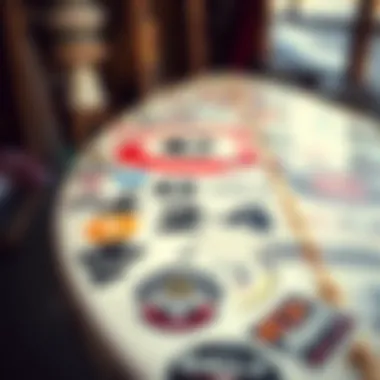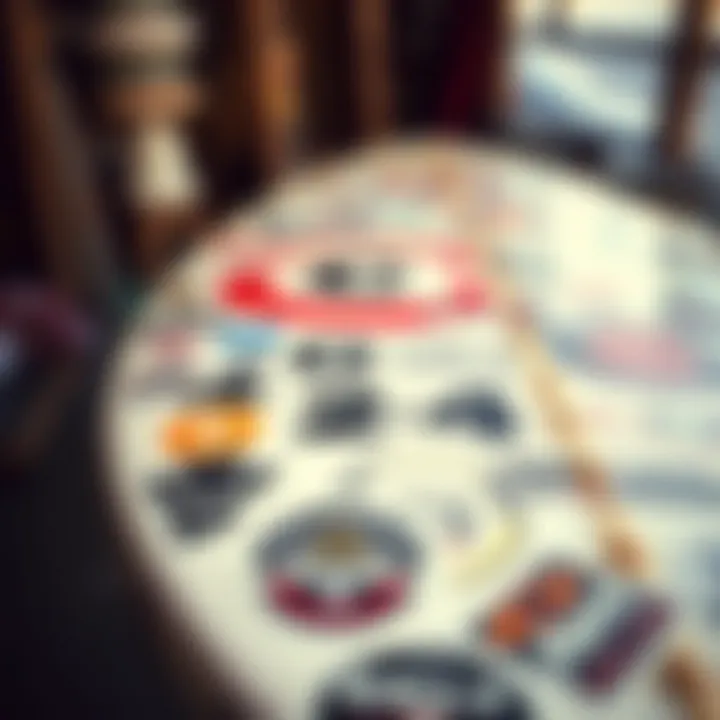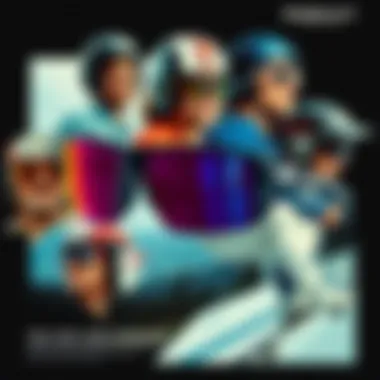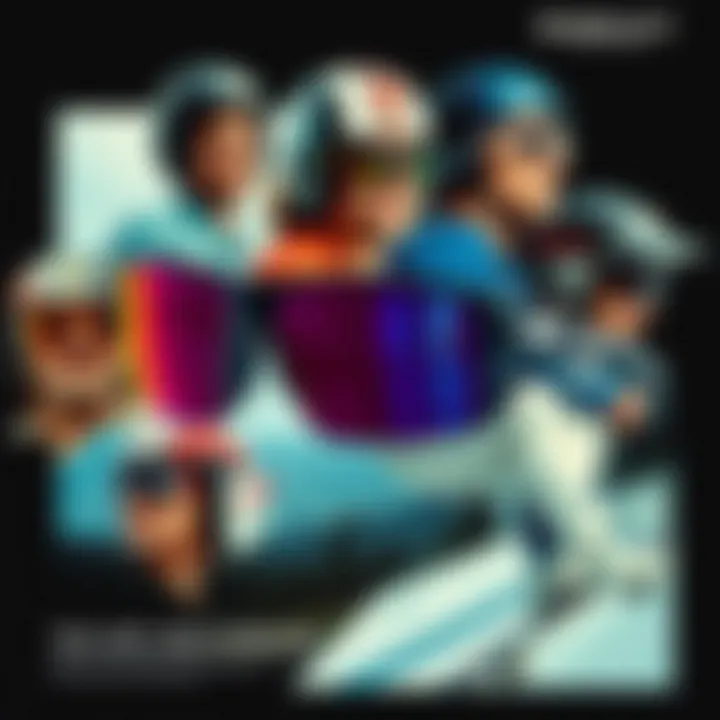The Rise of Oakley Sunglasses in 1980s Action Sports
Intro
The 1980s marked a pivotal shift in action sports, particularly within the realms of skateboarding and surfing. These activities transitioned from rebellious pastimes to recognized cultural phenomena, with elements of style and performance taking center stage. During this time, Oakley sunglasses emerged as more than just a fashion statement; they became a symbol of individuality and innovation in both the skate and surf communities.
As skateboarders and surfers sought out equipment that would enhance their performance and reflect their unique styles, Oakley managed to capture the spirit of the era. With a keen focus on technological advancements and a flair for design, these sunglasses provided not only eye protection but also a statement about the wearer’s identity and lifestyle.
This article ventures into the heart of the 1980s skate and surf culture, exploring how Oakley sunglasses influenced trends, endorsed by notable athletes and enthusiasts alike, transforming them into an essential accessory for anyone who wanted to skate or surf with authenticity. We’ll delve into the cultural context of the decade, highlight key figures who helped propel the brand into the limelight, and examine the specific innovations that set Oakley apart from its competitors.
Skateboarding Techniques
The adoption of Oakley sunglasses by the skateboarding community intertwined with the evolution of skateboarding itself. The techniques practiced on the streets and ramps during the 1980s demanded not only physical prowess but also a keen sense of style. As skaters began to push the envelope of what was possible, their choice of gear became crucial.
- Essential Tricks for Beginners
Skateboarding at its core involves a steep learning curve. For those just starting, mastering fundamental tricks sets the stage for progression. Key techniques include: - Advanced Maneuvers for Experienced Skaters
For those who have gained confidence and skill, advanced maneuvers come into play. Tricks that define your skating style often incorporate:
- Ollie: The foundation of many tricks, allowing skaters to pop the board off the ground.
- Kickflip: A natural evolution from the ollie, adding an extra spin.
- Manual: Balancing on the back wheels, crucial for maintaining speed and flow.
- 360° Flip: A combination of a kickflip and a pop-shuvit, showcasing skill and flair.
- Smith Grind: An essential trick in the repertoire of street skaters, presenting a blend of style and control.
- Heel Flip: A variant that adds complexity to the traditional kickflip.
Gear and Equipment Reviews
A skater's performance relies heavily on the quality of their gear. The selection of skateboards and protective equipment has increased significantly since the 1980s, setting new standards for safety and technique. During this period, Oakley sunglasses became synonymous with performance.
- Top Skateboards for Every Skill Level
When choosing a skateboard, it's important to match the board to one’s skill level. Popular brands of the time revolutionized skateboard design, ensuring that there was something for everyone: - Protective Gear: Importance and Recommendations
As the tricks evolved, so did the necessity for safety gear. Skaters had to protect themselves from injuries while pushing boundaries. Essential items include:
- Vision: Known for their iconic deck shapes and graphics, perfect for beginners and pros alike.
- Santa Cruz: A staple for skaters seeking durable setups with slick designs.
- Powell Peralta: These boards have a solid reputation, ideal for both street and vert skating.
- Helmets: Essential for avoiding serious head injuries. Brands like Bell and Protec gained popularity.
- Wrist Guards: They offer vital protection against falls during challenging tricks.
- Knee Pads: These help absorb impact during spills, allowing skaters to keep rolling after a wipeout.
In the evolving culture of the 1980s, Oakley sunglasses became an iconic part of the skater and surfer image. Their progressive approach to both style and technology captured a generation’s spirit, offering more than just eye protection—it provided a sense of belonging and identity. As we explore further, let's assess how these trends have influenced modern action sports, marking their indelible impact on the landscape of skateboarding and surfing.
Preface
The world of skateboarding and surfing saw significant changes in the 1980s, a decade that marked a turning point for many brands, especially Oakley. Emerging from a time when action sports were just gaining traction in the mainstream, Oakley began to make waves with its innovative sunglasses. The importance of this topic extends beyond mere aesthetics; it delves into how Oakley transformed functional eyewear into a lifestyle statement, embodying the spirit of the skater and surfer alike.
This article will unpack the intricate relationship between Oakley sunglasses and the subcultures of skateboarding and surfing. The focus will be on the specific elements that made Oakley a household name among enthusiasts. By exploring the emergence of the brand, we will see how its products reflected not just personal style but performance enhancement for athletes in these fast-paced sports. The considerations around brand endorsement, technological innovation, and cultural symbolism will be unraveled, illustrating how these eyeglasses became valuable assets within skate and surf communities.
Through a comprehensive examination, readers will grasp not only Oakley's impact during that iconic decade but also the lasting impressions it left on today’s action sports culture.
The Emergence of Oakley in the 1980s
Oakley started off as a mere motorcycle grip company but quickly burgeoned into a frontrunner in the world of sports eyewear. Founded in 1975 by James Jannard, Oakley's big break came in 1980 when they launched their first sunglasses model called the Oakley Factory Pilot. This piece of eyewear wasn’t just for protection against the sun; it was a punchy statement that resonated with a youthful audience craving an authentic skate and surf culture.
The adoption of unconventional materials, along with bold designs, set Oakley apart from competitors. For instance, Oakley sunglasses incorporated high-impact resistant lenses and rubber components, ensuring that they not only looked good but also performed exceptionally under the duress of action sports. As the skateboarding craze surged, fueled by pivotal figures like Tony Hawk and the rebirth of surfing culture through films and competitions, Oakley positioned itself as the go-to brand for athletes looking for durable and stylish options.
This was a time when aesthetics were often as crucial as practicality. To capture the attention of a young, rebellious demographic, Oakley used eye-catching colors and futuristic designs, which were groundbreaking in the eyewear market. This strategy paid off and established Oakley as a leader, and the sunglasses were soon seen everywhere – from skate parks to surf contests.
Connection to Skate and Surf Culture
The relationship between Oakley sunglasses and the skateboarding and surfing communities during the 1980s was mutually beneficial, creating a symbiotic connection that propelled both the brand and culture forward. Oakley didn’t just sell sunglasses; it integrated itself into the very fabric of these action sports.
For many skateboarders and surfers, wearing Oakleys became a badge of honor, signaling a certain lifestyle choice that was rebellious and free-spirited. The eyewear embodied not just protection from the sun but also a sense of identity among peers. As skateboarders pushed the limits of their sport, they wanted gear that could keep up with their high-energy lifestyle.
Many skateboarders began to sport the sleek designs, not only for their performance advantages but also for their unique flair. The same was true among surfers, who found that these shades matched their daring adventures on the waves. The popularity of Oakley sunglasses grew exponentially as they became symbols of status and authenticity within both communities.
In various skate competitions, the visibility of Oakley was prominent, as athletes proudly donned the brand, further weaving it into the tapestry of skate culture. Likewise, surfing films of the era often featured characters wearing Oakleys, enhancing their image as a cool, essential accessory. Thus, the bond between Oakley and these action sports could be summed up as not just a brand association but a deep and influential cultural connection that has endured through the decades.
Cultural Context of the 1980s
The 1980s was not just a decade; it was a cultural maelstrom that reshaped how various subcultures interacted with sports and style. During this time, skateboarding and surfing were not merely pastimes but were becoming integral parts of youth identity. The importance of understanding this context is crucial for grasping how brands like Oakley could seamlessly weave themselves into the fabric of action sports culture. The vibrant societal shifts, driven by a youthful desire for freedom, rebellion, and individuality, opened the door for brand innovations that celebrated and enhanced these lifestyles.
Societal Trends Influencing Action Sports
Several societal trends coalesced during this period that influenced the rise of action sports.


- Youth Empowerment: The youth of the 1980s began to assert their individuality more than ever before. Rejecting the mainstream narratives of older generations, they sought activities that emphasized self-expression. This was evident in the growth of skateboarding and surfing, where participants could define their own style and approach.
- Media Influence: The explosion of cable television and the advent of sports programming saw the rise of skate and surf videos, making these activities accessible and appealing to a broader audience. Films like "Thelma & Louise" and documentaries on skate culture showcased the thrill and artistry involved in these sports, inspiring countless youths.
- Urbanization: Many young people began migrating to urban centers where skate parks and ocean locales became hotspots for socializing and practicing. This population shift brought together enthusiasts, shaping a community that revolved around connection and competition.
The confluence of these societal factors not only fostered a culture of innovation but also fueled the desire for high-performance gear that could elevate the experience. As skate and surf cultures blossomed, brands like Oakley were quick to respond, developing technologies that would influence the very essence of these sports.
The Rise of Skateboarding and Surfing
The resurgence of skateboarding and surfing in the 1980s was more than a trend; it was a full-blown cultural renaissance.
- Skateboarding: Originally associated with rebellion and youthful insubordination, skateboard culture saw a significant evolution. Riders began forming tight-knit communities, pushing the boundaries of what was possible on a board. The creation of elaborate tricks and styles turned skateboarding into an art form. The rise of iconic brands and key figures, many of whom endorsed Oakley, served to solidify the sport's legitimacy.
- Surfing: Similarly, surfing transitioned from a niche activity to a popular sport, with films and competitions bringing it into the limelight. The surfers of the 80s were not just athletes but also icons of style and culture. They embodied the laid-back California lifestyle, making surf culture aspirational for many.
The increasing popularity of these sports was also supported by improved accessibility, such as the proliferation of skate shops and surf schools. Enthusiasts from various backgrounds began to join the scene, each contributing to its diversity and creativity. Essentially, skateboarding and surfing weren't just activities; they became holistic expressions of a generation's ethos.
In understanding the cultural context of the 1980s, it becomes evident how specialized products like Oakley sunglasses weren't simply fashion statements; they were essential tools that enhanced performance, shaped identities, and carved out a place within the broader landscape of youth culture.
Technological Innovations in Oakley Sunglasses
The impact of technological innovations in Oakley sunglasses cannot be overstated, especially during the transformative era of the 1980s. As skateboarding and surfing surged in popularity, athletes demanded more than just stylish lenses; they needed gear that enhanced performance and ensured safety. Oakley became synonymous with pioneering technology that answered these needs, playing a crucial role in elevating standards within action sports.
Several aspects of these innovations are worth considering:
- Advanced Materials: Oakley differentiated itself through the use of high-quality materials that were not only lightweight but also durable. For instance, the introduction of O Matter, a proprietary plastic, provided flexibility and resilience, allowing sunglasses to withstand the rigors of both skateboarding and surfing. This material set a new benchmark in eyewear, pushing competitors to rethink their designs.
- Optical Clarity: In a world where vision accuracy shapes performance, Oakley focused heavily on lens technology. While other brands were using basic tinted lenses, Oakley developed the precision optics that provided unrivaled clarity and increased contrast. As a result, athletes could discern subtle changes in their environments—whether it was the texture of a wave or the imperfections on a skate ramp.
These innovations played a significant role in how the brand was perceived among consumers and athletes alike. They were not just buying a fashion statement, they were investing in tools made specifically for their sport, fundamentally trusting Oakley with their performance.
"Choosing Oakley wasn’t just about looking cool. It was also about flying high without losing sight of the ground. Performance was key."
Materials and Design Innovations
The distinction between Oakley and its competitors can largely be attributed to their materials and design innovations. Unlike many brands that focused primarily on aesthetics, Oakley sculpted its sunglasses for functionality first and foremost. For example:
- Durability: The flexibility and strength of O Matter meant that frames could absorb shocks without breaking. This is particularly vital for skateboarders who face constant falls and impacts.
- Comfortable Fit: Oakley incorporated adjustable nose pieces and temple arms, enabling a customized fit. This was critical for surfers who often used their gear in extremely active scenarios, where comfort translates into performance.
Because of these innovations, Oakley sunglasses not only succeeded in the competitive arena of sunglass design, but they carved out a niche that appealed directly to enthusiasts of action sports.
Functionality and Performance Advantages
The functionality of Oakley sunglasses reached beyond just aesthetics; they enhanced athletes' performance in significant ways:
- UV Protection: The lenses offered comprehensive UV protection, which is crucial when spending long hours outdoors. For surfers, the harsh glare from water can be blinding, and Oakley targeted this need with polarized lenses that reduced glare while maintaining visual acuity.
- Impact Resistance: Oakley's lenses were also engineered to resist impacts, adhering to standards that were ahead of their time. Skateboarders, who often faced unpredictable falls, benefited greatly from lenses that would not shatter upon impact.
In summary, the technological innovations introduced by Oakley during the 1980s not only set the brand apart but revolutionized the performance standards in action sports eyewear. Enthusiasts understood that choosing Oakley was a commitment to performance, safety, and style.
Iconic Oakley Models from the 1980s
The 1980s were a transformative era not just for action sports, but also for style and design, and Oakley sunglasses played a pivotal role in this revolution. Their models from this decade are not simply eyewear; they're milestones that reflect the culture and the vibrant energy of skateboarding and surfing.
The Oakley Frogskin
The Oakley Frogskin burst onto the scene in 1985 and quickly became a staple among skaters and surfers alike. What made this model stand out wasn't just the vivid colors and unique shapes, but also the lightweight design that was perfect for both high-impact sports and casual beach days. The Frogskin was one of the first sunglasses to effectively merge functionality with bold aesthetics.
- Design Appeal: The Frogskin came in an array of vibrant hues and patterns, making them a fashion statement that transcended mere utility. Young surfers and skateboarders embraced them for their eye-catching presence.
- Cultural Boom: This model encapsulated the surf and skate culture, allowing wearers to express their individuality. When you saw someone sporting a Frogskin, it wasn't just an accessory; it was a badge of identity within those communities.
- Material Advantage: Made from a lightweight plastic, the Frogskin offered comfort that was hard to rival. Skaters often remarked how they could pull off tricks without concern for their eyewear shifting out of place.
The Oakley Factory Pilot
The Oakley Factory Pilot, released shortly after the Frogskin, was dripping with performance-oriented features that appealed to the sport's elite. More than just a fashion accessory, these shades were crafted with the athlete in mind.
- Function Meets Form: This model boasted a durable frame and superior lens technology, including UV protection and anti-fog features. As athletes pushed their limits, they required eyewear that could keep up. The Factory Pilot answered that call.
- Athlete Endorsements: Influential skateboarders and surfers got behind this model, helping to cement its place in the culture. Names like Tony Hawk and Kelly Slater were often spotted in these shades, which significantly contributed to the model's popularity.
- Technological Breakthroughs: The innovations embedded in the Factory Pilot, such as improved hydrophobic coatings, dramatically enhanced visibility during intense action. This was not just eyewear but an extension of the athlete’s competitive edge.
The legacy of these iconic models extends far beyond their initial designs; they influenced trends that shaped the overall landscape of apparel in extreme sports. As oakley sunglasses became more than equipment—they transformed into symbols of style and defiance—creating a framework for future designs in action sports eyewear.
"The Frogskin and Factory Pilot weren't just shades; they were endorsements of an all-in attitude that defined the sport."
In many ways, Oakley cemented its position not just as a brand but as a cornerstone of identity in skate and surf communities during the 1980s.


Influence of Oakley on Professional Athletes
Oakley sunglasses didn’t just redefine how people looked while skating or surfing; they became an essential part of the professional athlete’s toolkit. Athletes, specifically skateboarders and surfers, actively shaped the brand, lending it credibility and visibility that caught the attention of the youth market. The synergy between Oakley and these sports fostered a cultural connection that resonated deeply within both communities. Through endorsements and partnerships, professional athletes wore their Oakleys not just as accessories, but as symbols of their identity and lifestyle.
Skateboarders Who Endorsed Oakley
In the bustling world of skateboarding, where style is nearly as important as skill, endorsements played a crucial role in establishing Oakley’s prominence. Athletes like Tony Hawk and Steve Caballero became synonymous with the brand. As each one carved their name into skate history, their choice to wear Oakley sunglasses brought the products into the spotlight.
The endorsement of these skate legends was a game changer. When Tony Hawk performed his jaw-dropping tricks while donning oakley shades, fans weren't just witnessing amazing skateboarding; they were watching a trend unfold. The sunglasses were no longer merely protective eyewear against the sun; they represented a lifestyle dominated by dedication, rebellion, and creativity.
- Tony Hawk
- Steve Caballero
- Venerated for his gravity-defying stunts.
- Hawk’s choice of Oakley solidified the brand among youth.
- Renowned for his legendary blend of art and skate skills.
- Embraced the brand as part of his unique style and persona.
The phenomenon didn’t stop there. Other skateboarders started to buy into the brand, increasing its visibility and aligning it with the rebellious spirit of skate culture. Wearing Oakleys on their heads as much as on their faces became a norm, amplifying the brand’s reach.
Surfers and Their Relationship with the Brand
On the other side of the ocean, surfers also harmonized with Oakley, fostering a similar culture of representation and identity. Surfers like Kelly Slater and Robby Naish showcased the sunglasses in extreme conditions, testing not just their performance but also amplifying the prominence of the Oakley name in surf culture.
The relationship between surfers and Oakley was special; it wasn’t just about aesthetics or trends, it was about functionality. These athletes utilized the sunglasses to withstand harsh sunlight while riding the waves, making them an intrinsic part of their gear. The brand's association with elite athletes helped it gain a reputation for quality alongside its stylish appeal.
- Kelly Slater
- Robby Naish
- Multi-time World Champion whose influence transcended beyond the beach.
- His endorsement transformed Oakley from just a brand to a surf essential.
- A windsurfing legend who brought attention to the versatility of the products.
- His adventurous spirit mirrored the ethos of Oakley itself.
"In the 1980s, the action sports arena was more than a competition; it was a cultural movement wherein Oakley, backed by athlete endorsements, became a pivotal player in defining the aesthetic of that era."
The strategic partnerships fostered a community that resonated with the ideologies of dedication, performance, and a touch of daring, securing a legacy that would echo through both skateboarding and surfing history. The athletes didn't merely endorse a product; they defined a culture. This relationship laid the foundation for Oakley's rise as a dominant force in action sports that endures to this day.
Advertising Strategies in the 1980s
In the vibrant and dynamic landscape of the 1980s, advertising emerged not just as a vehicle for promoting products, but as a cultural force in its own right. This period for Oakley sunglasses, particularly within skateboard and surf circles, illustrates how strategic marketing could resonate deeply with a youthful audience. Understanding the advertising strategies of this era offers a window into the minds of a generation that valued authenticity, individuality, and innovation.
Marketing Targeted Toward Youth Culture
Focusing on the youth market wasn’t just a tactic; it was the essence of Oakley’s approach. The 1980s were teeming with youth-centered movements, from the punk rock scene dictating fashion to the emerging popularity of action sports, which were seen as inherently rebellious and free-spirited. Oakley capitalized on this by tailoring its marketing messages to speak directly to the desires and lifestyles of young skateboarders and surfers. This was done in several ways:
- Street Credibility: Engaging with pro athletes and influencers in the skate and surf communities, Oakley effectively borrowed their credibility. These endorsements were not merely about product placements but about aligning the brand with an authentic way of life.
- Visual Aesthetics: Ads featured vibrant, rebellious imagery that mirrored the culture itself—think bright colors, action shots, and raw, unfiltered moments of athletes in their element. This approach captured the essence of youth expression, resonating well with their audience.
- Lifestyle Marketing: Oaks was not just selling sunglasses; they were selling a lifestyle that encompassed freedom, thrill, and defiance. Their advertisements often depicted scenarios of skateboarding and surfing, transporting viewers into a world where these activities were not just hobbies, but a way of life.
Use of Action Sports in Campaigns
The integration of action sports into Oakley’s marketing strategies was nothing short of revolutionary. The brand didn’t just use athletes to promote their products; they crafted entire campaigns around the culture of these sports. By doing so, they bridged the gap between the product and a passionate community of enthusiasts. Here are some key aspects of this strategy:
- Sponsorship Deals: Teaming up with well-known skateboarders and surfers was a masterstroke. Not only would these athletes sport Oakley shades during competitions, but their personal endorsements in ads fostered a sense of trust and aspiration among their fans.
- Event Sponsorship: Oakley was also proactive in sponsoring events that were central to skate and surf culture. By putting their brand name on competitions, they solidified their position within these communities while creating another touchpoint for engagement.
- Media Collaborations: Aligning with skate and surf magazines was a crucial move. These publications served as a direct line to the audience that Oakley was targeting. Ads in these venues were strategically placed to ensure visibility, directly raising brand awareness.
In summary, the advertising strategies Oakley employed in the 1980s were not merely attempts to sell sunglasses; they were thoughtful, well-crafted efforts to embed the brand within the very fabric of youth culture and action sports. The impact of these strategies laid a foundational legacy for what Oakley stands for today, marking the brand as a significant player not only in performance eyewear but also in the identity and culture of skateboarding and surfing.
Cultural Impact of Oakley Sunglasses
The cultural impact of Oakley sunglasses during the 1980s extended far beyond their practical function of eye protection. These sunglasses became a staple in the wardrobes of skateboarders and surfers alike, signifying a lifestyle rooted in freedom and rebellion. The emergence of Oakley as a status symbol reflected broader societal shifts towards individualism and self-expression, encapsulating the ethos of the action sports culture that was gaining momentum at the time. The sunglasses weren't just accessories; they embodied the spirit of an entire generation, standing at the intersection of sports, style, and community.
Symbolism in Skateboarding Culture
In the realm of skateboarding, Oakley sunglasses took on a deeper significance, often representing a badge of honor among enthusiasts. The bold and distinctive designs of models like the Frogskin resonated with the skate community, which valued uniqueness and authenticity. Skateboarding, with its roots in countercultural movements, was all about challenging norms. Oakley’s commitment to innovation and performance mirrored these values. For many, wearing Oakley sunglasses was akin to wearing a trophy; it signaled that one was not just a part of the skateboard scene but actively engaged in its evolution.
The significance of Oakley in skateboarding can also be seen through its association with legendary skateboarders of the time. Influential names like Tony Hawk and Steve Caballero, who wore Oakley not only during competitions but also in their everyday lives, solidified the brand’s connection with the skateboarding ethos. > "To see someone like Tony Hawk with Oakley sunglasses made it feel like you were part of the cool crowd. They were as important as the skateboard itself."
This sense of community was amplified through skate parks and competitions where Oakley presence was strong, making it synonymous with the gritty enthusiasm of skate culture. Wearing a pair of Oakleys was not just a fashion statement; it was a way to express belonging and authenticity within a rebellious and dynamic subculture.


Integration into Surfing Lifestyle
Similarly, in the surfing domain, Oakley sunglasses were woven into the fabric of surf culture, where style and function are intrinsically linked. Surfers require eyewear that can withstand the rigors of sun, salt, and surf, and Oakley provided solutions that catered to these needs. The lightweight materials and durable designs of Oakley eyewear quickly became favored among surfers, allowing them to focus on the waves rather than worrying about their gear.
The imagery associated with Oakley sunglasses painted a picture of sun-kissed beaches, thrilling rides, and camaraderie amongst surfers. This branding captured the essence of a leisurely yet adrenaline-fueled lifestyle. Oakley was not merely selling sunglasses; they were marketing a lifestyle, one that conveyed adventure, passion, and a connection to nature. Surfers like Kelly Slater and Rob Machado donned Oakley sunglasses both in and out of the water, further influencing the perception that these sunglasses were not only functional but an essential part of a surf enthusiast's gear.
The connection that Oakley forged with the surfing community ran deep, becoming entwined with the cultural narrative of surf movies, competitions, and sponsorship deals that significantly shaped surf culture in the 1980s. This integration solidified Oakley sunglasses as a core component of the surfing lifestyle, making them a must-have item for anyone serious about riding the waves.
The Legacy of 1980s Oakley Sunglasses
The legacy of Oakley sunglasses from the 1980s extends far beyond their sleek design and functionality. This period marked a significant turning point not only for the brand but also for the action sports landscape. Oakley, through its innovative spirit and strategic partnerships, established itself as a vanguard of both style and performance, reshaping how sunglasses integrated into the ethos of skateboard and surf culture.
The world of action sports during the 1980s was rich with rebelliousness and a sense of individuality. Oakley's emergence coincided perfectly with this. Instead of just being a fair-weather accessory, Oakley sunglasses became a badge of honor. They symbolized a commitment to sport, freedom, and self-expression. Skateboarders and surfers alike found in Oakley not just a product, but a companion for their adrenaline-fueled escapades.
As the decade progressed, the impact of Oakley's sunglasses was palpable. They set a new standard for both aesthetics and performance. Shifting away from the mundane, the introduction of models like the Frogskin and the Factory Pilot pushed boundaries. These designs were not just functional; they became statements reflecting the cultural zeitgeist—a mix of bold colors, cutting-edge materials, and a flair that screamed 'cool.'
Influence on Later Designs and Trends
The 1980s laid the groundwork for what we see in eyewear today, and Oakley's influence is staunchly evident in later designs and trends. The brand's dedication to utilizing advanced technology and stylish design paved the way for a generation of sunglasses that would prioritize both function and fashion.
- Innovations in Materials: Oakley introduced proprietary materials like O Matter™ for frames, which are not only lightweight but also sturdy, setting a precedent for future eyewear brands to push for similar advancements.
- Design Aesthetics: The bold, angular lines and vibrant colors of Oakley's sunglasses initiated a cultural shift in how athletes and enthusiasts viewed accessories. Later brands began taking cues from this design philosophy, leading to a proliferation of styles that allowed individuals to express their personal identity through their eyewear.
- Performance Features: Many later brands began adopting Oakley's emphasis on performance, incorporating UV protection, anti-fog coatings, and lightweight designs that became standard across the industry.
As a result, the echoes of 1980s Oakley sunglasses can still be seen in modern action sports eyewear, continuously influencing new releases and innovations.
Continued Relevance in Action Sports
Even decades after their debut, Oakley remains a cornerstone in action sports, with their sunglasses as synonymous with skateboarding and surfing as the boards themselves. This continued relevance speaks to how deeply Oakley intertwined itself with the culture:
- Adoption by New Generations: Younger skaters and surfers still look up to the legends who wore Oakley in the 80s and emulate their style, signaling that these sunglasses maintain their status as a rite of passage.
- Brand Evolution: Oakley has skillfully evolved over the years, introducing newer models while preserving the essence of what made their 80s designs beloved. For example, even in today’s market, variations of the original Frogskin continue to attract attention and sales, proving timelessness in design.
- Cultural Events: The brand consistently sponsors high-profile events in the skate and surf communities, ensuring that they remain at the forefront of action sports. This marketing strategy keeps Oakley relevant and engrained in the community's ongoing narrative.
In summary, the legacy of 1980s Oakley sunglasses is rich with innovation and cultural integration. The brand not only shaped the eyewear landscape but also embedded itself within the heart of skate and surf culture, establishing a blueprint for future trends and maintaining its relevance in today's market.
Contemporary Perspectives on Oakley Sunglasses
The way we view Oakley sunglasses today reflects a complex interplay of nostalgia, innovation, and cultural significance. Initially gaining traction in the 1980s, the brand has evolved considerably, yet it has retained the essence that captivated a generation. Understanding contemporary perspectives on Oakley sunglasses involves examining their nostalgic value among enthusiasts and recognizing how the brand navigates current innovations and market positioning.
Nostalgic Value for Enthusiasts
For many, Oakley sunglasses are not just a functional accessory; they symbolize a lifestyle steeped in the vibrant culture of skateboarding and surfing. The connection is deeply rooted in memories associated with youth and rebellion. This nostalgia is often conveyed through a vivid recollection of the excitement that surrounded the 1980s action sports scene.
- Many who wore Oakley sunglasses in their youth reminisce about epic skate sessions and endless summer days at the beach.
- These experiences transform Oakley from mere eyewear to a cherished emblem of carefree days and youthful exuberance.
Names like the Frogskin or the Factory Pilot are more than just model identifiers; they evoke images of board tricks caught mid-air or waves crashing on a sunny day. For enthusiasts, collecting vintage Oakley models has become a passion, a way to reconnect with that exhilarating time. The community around these collectors often fuels this nostalgia through online forums, social media groups, and even local meet-ups. A discussion might uncover gems—a rare colorway or a limited edition that reminds someone of that first skateboard trick landed or a memorable surf session.
Current Innovations and Market Positioning
Now, even though the past is revered, Oakley isn't just resting on its historical laurels. The brand continues to push boundaries, adapting to new trends in technology and style. With advances in lens and frame materials, Oakley modernizes its offerings while still maintaining elements that harken back to its roots.
- For instance, modern Oakley lenses feature enhanced UV protection and scratch resistance, catering to the active lifestyles of today’s athletes.
- New frame designs focus on comfort and fit, ensuring that they stay secure during high-intensity activities, which is crucial for skaters and surfers alike.
In terms of marketing, Oakley has shifted its approach to resonate with younger audiences. Leveraging platforms like Instagram and TikTok, they successfully engage fans by showcasing vibrant imagery and collaborations with influential athletes. Especially notable is their partnership with prominent action sports figures who embody the brand’s spirit and lifestyle.
Despite the changing landscape of fashion and technology, Oakley manages to keep its place as a sought-after brand in action sports while catering to a new generation that values authenticity and performance. This duality—new innovations and a legacy of nostalgia—ensures Oakley's relevance in today’s market.
"Nostalgia and innovation are not mutually exclusive. Oakley embodies both, merging the past with the future, offering its enthusiasts a glimpse of both worlds."
End
As we draw the curtain on our exploration of Oakley sunglasses' dramatic rise in the 1980s, it becomes clear how intertwined this brand is with the fabric of skate and surf culture. The sunglasses weren’t merely a product; they became a symbol of identity for countless enthusiasts. Oakley’s innovative designs combined functionality with style, providing athletes with the gear they needed to push boundaries while looking cutting-edge.
Reflecting on Oakley’s Role in Skate and Surf History
Through the lens of history, Oakley emerged not just as a brand but as a cornerstone of a cultural shift that marked the 1980s. Skateboarders and surfers alike saw these sunglasses as essential gear, blending performance with personal style. Athletes sporting Oakley became innovators in their communities, riding waves and grinding ledges while also pushing trends in aesthetics.
For many, these sunglasses functioned as both a protective accessory and a fashion statement, embedding Oakley deeply into the lifestyle of action sports. Its connection to respected figures in both skateboarding and surfing helped embed the brand’s legacy firmly in pop culture. With endorsements from influential athletes, the brand garnered a reputation synonymous with quality and cutting-edge technology. Their style wasn’t static—it morphed and evolved alongside the community that embraced them.
What Lies Ahead for the Brand
Looking toward the future, Oakley continues to hold a prominent position in both skate and surf contexts. The essence of what made the sunglasses iconic in the 1980s lives on, yet the brand must navigate a marketplace that constantly changes. Innovations in materials and designs are paramount, especially in an age where sustainability is also a growing concern.
Further, Oakley’s commitment to brand loyalty and community engagement places it in a favorable position. Only time will tell how well it adapts to events like the rise of digital marketing and the changing preferences of new generations. However, if the history of Oakley in the 1980s is any indicator, the brand has a solid foundation upon which to build. The challenge will be to retain that cultural relevance while remaining at the forefront of technological advancements.







